Orpheus Island Lodge off Townsville a luxury gateway to Great Barrier Reef
Lap up the watery wonders of the Great Barrier Reef at this classy lodge.
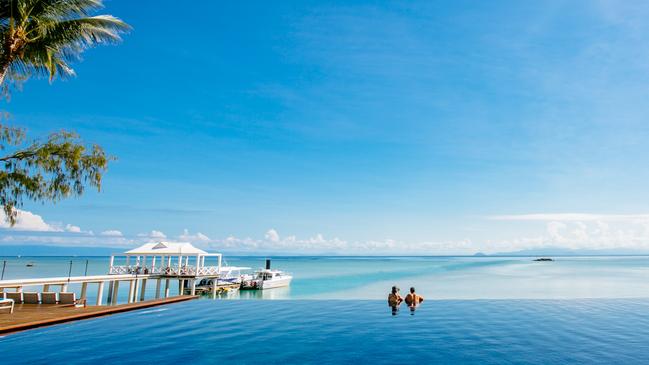
Black-tip reef sharks are patrolling the aquamarine waters around the jetty at Orpheus Island Lodge. They glide between the pylons and tenders, occasionally flicking their streamlined tails and worrying the mullet sharing the shallows with them. They may be harmless to humans but they’re still in the back of my mind, especially one 1.5m-long specimen, as I don a wetsuit and clamber aboard a motorised dinghy for a spot of solo snorkelling.
Steering the tinny slowly out the channel that leads to open water, I hang a right and head towards a mooring about 15 minutes away. Having secured the boat, I feel nervous about slipping into the water on my own but what lies beneath soon banishes any thoughts of sharks or other toothy marine inhabitants. Below me is a mesmerising garden of giant clams, their velvety, brightly coloured lips like the openings on enormous clutch purses.
Orpheus Island, located 80km off the coast of Townsville, sits within the Great Barrier Reef Marine Park. Of the 1500 species of fish found on the reef, more than 1000 can be seen in its nearby waters. The island stretches for 11km, with a coastline alternating between hardy mangroves, rock-strewn bays and sandy arcs.
Most of Orpheus was declared a national park in 1960, but the land and ocean weren’t always treated with respect. Since 2011, when it was purchased by Chris Morris, who made his fortune with share registry company Computershare, great efforts have been made to nurture and restore the site. The resort is now a certified Advanced Ecotourism Property; a waste water treatment plant has been installed, guest numbers significantly reduced and, on my two-night visit, a new solar power plant is kicking in to gear.
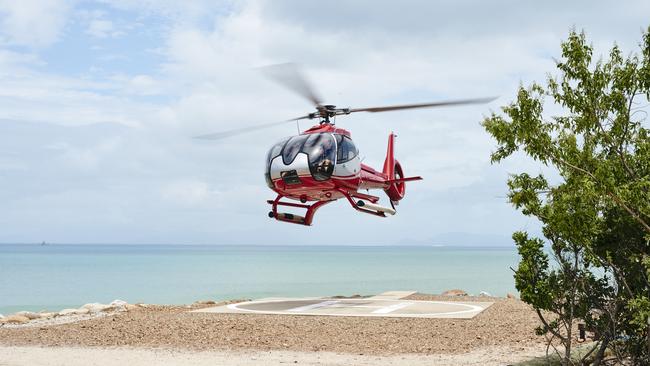
These green credentials haven’t lowered the luxe factor. My visit kicks off with a 30-minute flight in a shiny Nautilus Aviation helicopter from Townsville. My fellow passengers and I spy dugongs grazing near the coast, a manta-ray skirting the island’s fringing reef and, to top it all off, a humpback whale breaching in the royal blue depths.
On landing, we are escorted across the immaculate lawn and past a black-tiled infinity pool to an open-air pavilion where flutes of bubbles are waiting. The island has been a popular vacation spot for mainlanders since the 1930s, and I browse the black and white photos of perfectly coiffed holiday-makers in modest swimsuits that adorn the walls. We’re given a run-down of activities and meal schedules then it’s off to check out my five-star digs.
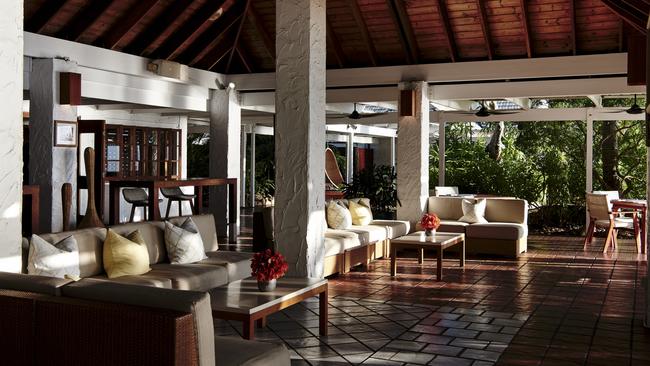
The resort has only 14 rooms, suites and villas, accommodating an intimate coterie of no more than 28 guests.
My South Suite faces the Coral Sea and is bright and breezy, reflecting its surrounds with sand-hued floorboards, white and mint green linen on the king bed, and soft greys in the adjoining lounge area. An al fresco bathtub awaits in the private courtyard, while inside are a double rain shower, twin vanities and Li’Tya amenities.
The complimentary minibar tempts with an array of Australian and New Zealand wines plus there are T2 teas and a Nespresso machine. A welcoming bottle of champers and a sumptuous cheese platter are demanding my attention, but I have to rein myself in because the all-inclusive dining at Orpheus is a generous affair. Breakfasts run the gauntlet from pancakes with caramelised banana to omelettes with a Thai twist.

Lunches are themed around cuisines from across the globe: Mexican, Asian, Italian and beyond. Four-course dinners, with optional wine pairings, are standard offerings each night, but I am lavished with six exquisitely plated dishes at a secluded table on the jetty. I can hear fish splashing in the ocean beneath as I’m served seared scallops, perfect pockets of goat cheese tortellini and a creamy truffled mushroom risotto.
The following day I meet Jen Truasheim, who has been the resort’s gardener for about 20 years. She has seen a lot of changes in her time — mostly for the better. She leads guests on a tour of the grounds, showing us the vegetable plots and her “girls”, the chickens that furnish the kitchen with eggs.
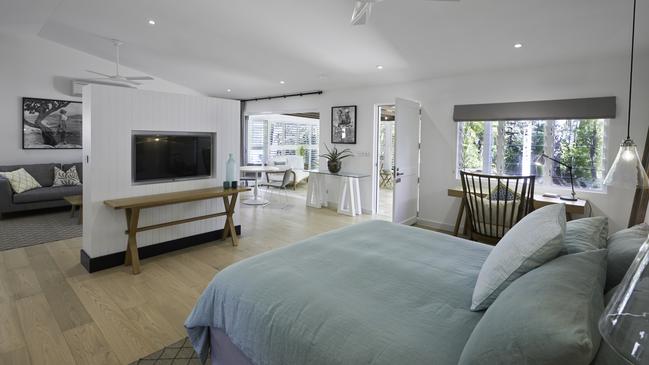
We’re escorted up into the hills behind the resort, where Orpheus can be viewed in all its glory. For such a compact place, there’s no shortage of diversity. We see evidence of the island’s past life as a sheep and cattle farm, pockets of tropical rainforest and strands of eucalypts surrounded by spinifex. We keep an eye out for bandicoots and spot a sea eagle soaring far above us. Hinchinbrook looms like a monstrous Jurassic park to the northwest, and to the east is Palm Island, established as an Aboriginal mission in 1918 and now the largest indigenous community in Queensland.
But it’s the water that is the constant drawcard here. At low tide, guests borrow rubber booties to explore the flats, looking for stingrays and crabs. When the tide is in, couples on stand-up paddle boards and kayaks float languidly around the bay. One morning, I wake before dawn, head to the beach and slide a kayak quietly into the still water. Startled fish leap in front of the prow as I cruise from one side of the bay to the other. The sun, rising over the island’s low waist, suddenly catches me in its beams. It feels like a very private slice of paradise.
Penny Hunter was a guest of Northern Escape Collection and Tourism and Events
Queensland.
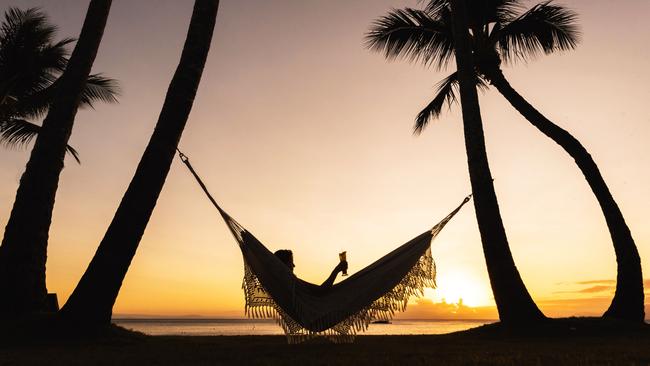
-
IN THE KNOW
Rooms at Orpheus Island Lodge start at $1600 a night, twin-share, including meals, Australian beer, wine and soft drinks, minibar, unlimited use of stand-up paddle boards, kayaks, catamarans and motorised dinghies and daily experiences. The South Suite costs from $2400 a night, twin-share. Daintree Ecolodge has rooms from $380 a night, twin-share. A Canopy Bayan is from $435 a night, twin-share.
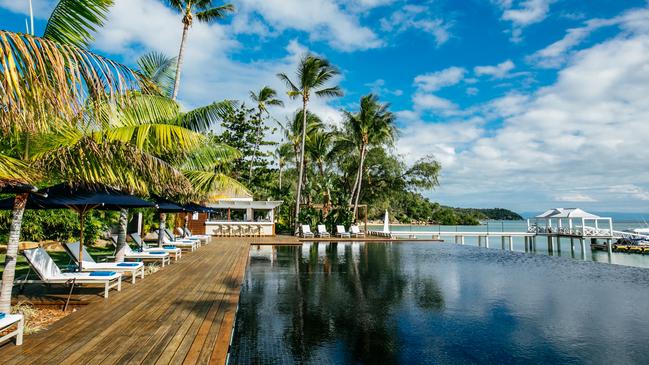
-
MORE TO THE STORY
A spectacular drive through the cane fields north of Cairns, along the coast and into the World Heritage-listed Daintree rainforest leads to another Northern Escape Collection property. Daintree Ecolodge comprises 15 bayans, or tree houses, nestled among magnificent bull kauri trees. Situated on Kuku Yalanji country, the lodge has a nearby waterfall where indigenous women traditionally went to give birth. During torrential rains in January, the lodge’s restaurant and some of the bayans suffered significant flood damage. Three cabins remain out of action but Julaymba restaurant (pictured) was back in business in record time.
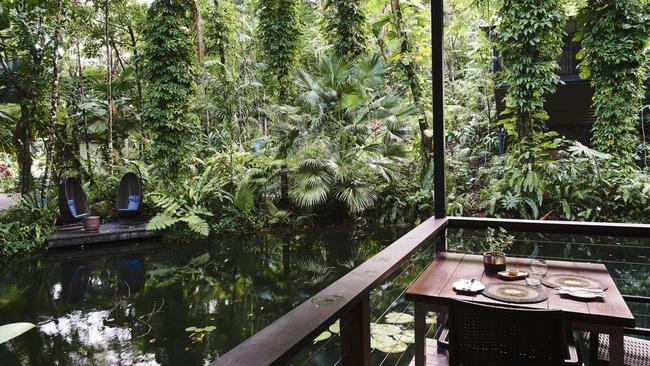
Local, seasonal and organic produce is the focus here, with a menu that is innovative and colourful. Think ingredients such as emu, mountain pepper, palm heart, green ants and lemon myrtle. It’s a peaceful venue that looks out over a waterhole surrounded by lush vegetation. Guests can retire after dinner to a cabin in the tree tops and fall asleep to the chirping and twittering of the forest night.

To join the conversation, please log in. Don't have an account? Register
Join the conversation, you are commenting as Logout